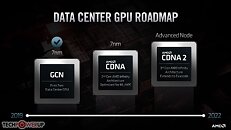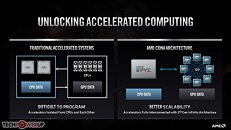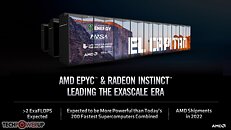Friday, March 6th 2020

AMD Announces the CDNA and CDNA2 Compute GPU Architectures
AMD at its 2020 Financial Analyst Day event unveiled its upcoming CDNA GPU-based compute accelerator architecture. CDNA will complement the company's graphics-oriented RDNA architecture. While RDNA powers the company's Radeon Pro and Radeon RX client- and enterprise graphics products, CDNA will power compute accelerators such as Radeon Instinct, etc. AMD is having to fork its graphics IP to RDNA and CDNA due to what it described as market-based product differentiation.
Data centers and HPCs using Radeon Instinct accelerators have no use for the GPU's actual graphics rendering capabilities. And so, at a silicon level, AMD is removing the raster graphics hardware, the display and multimedia engines, and other associated components that otherwise take up significant amounts of die area. In their place, AMD is adding fixed-function tensor compute hardware, similar to the tensor cores on certain NVIDIA GPUs.AMD also talked about giving its compute GPUs advanced HBM2e memory interfaces, Infinity Fabric interconnect in addition to PCIe, etc. The company detailed a brief roadmap of CDNA looking as far into the future as 2021-22. The company's current-generation compute accelerators are based on the dated "Vega" architectures, and are essentially reconfigured "Vega 20" GPUs that lack tensor hardware.
Later this year, the company will introduce its first CDNA GPU based on "7 nm" process, compute unit IPC rivaling RDNA, and tensor hardware that accelerates AI DNN building and training.
Somewhere between 2021 and 2022, AMD will introduce its updated CDNA2 architecture based on an "advanced process" that AMD hasn't finalized yet. The company is fairly confident that "Zen4" CPU microarchitecture will leverage 5 nm, but hasn't been clear about the same for CDNA2 (both launch around the same time). Besides ramping up IPC, compute units, and other things, the design focus with CDNA2 will be hyper-scalability (the ability to scale GPUs across vast memory pools spanning thousands of nodes). AMD will leverage its 3rd generation Infinity Fabric interconnect and cache-coherent unified memory to accomplish this.
Much like Intel's Compute eXpress Link (CXL) and PCI-Express gen 5.0, Infinity Fabric 3.0 will support shared memory pools between CPUs and GPUs, enabling scalability of the kind required by exascale supercomputers such as the US-DoE's upcoming "El Capitan" and "Frontier." Cache coherent unified memory reduces unnecessary data-transfers between the CPU-attached DRAM memory and the GPU-attached HBM. CPU cores will be able to directly process various serial-compute stages of a GPU compute operation by directly talking to the GPU-attached HBM and not pulling data to its own main memory. This greatly reduces I/O stress. "El Capitan" is an "all-AMD" supercomputer with up to 2 exaflops (that's 2,000 petaflops or 2 million TFLOPs) peak throughput. It combines AMD EPYC "Genoa" CPUs based on the "Zen4" microarchitecture, with GPUs likely based on CDNA2, and Infinity Fabric 3.0 handling I/O.
Oh the software side of things, AMD's latest ROCm open-source software infrastructure will bring CDNA and CPUs together, by providing a unified programming model rivaling Intel's OneAPI and NVIDIA CUDA. A platform-agnostic API compatible with any GPU will be combined with a CUDA to HIP translation layer.
Data centers and HPCs using Radeon Instinct accelerators have no use for the GPU's actual graphics rendering capabilities. And so, at a silicon level, AMD is removing the raster graphics hardware, the display and multimedia engines, and other associated components that otherwise take up significant amounts of die area. In their place, AMD is adding fixed-function tensor compute hardware, similar to the tensor cores on certain NVIDIA GPUs.AMD also talked about giving its compute GPUs advanced HBM2e memory interfaces, Infinity Fabric interconnect in addition to PCIe, etc. The company detailed a brief roadmap of CDNA looking as far into the future as 2021-22. The company's current-generation compute accelerators are based on the dated "Vega" architectures, and are essentially reconfigured "Vega 20" GPUs that lack tensor hardware.
Later this year, the company will introduce its first CDNA GPU based on "7 nm" process, compute unit IPC rivaling RDNA, and tensor hardware that accelerates AI DNN building and training.
Somewhere between 2021 and 2022, AMD will introduce its updated CDNA2 architecture based on an "advanced process" that AMD hasn't finalized yet. The company is fairly confident that "Zen4" CPU microarchitecture will leverage 5 nm, but hasn't been clear about the same for CDNA2 (both launch around the same time). Besides ramping up IPC, compute units, and other things, the design focus with CDNA2 will be hyper-scalability (the ability to scale GPUs across vast memory pools spanning thousands of nodes). AMD will leverage its 3rd generation Infinity Fabric interconnect and cache-coherent unified memory to accomplish this.
Much like Intel's Compute eXpress Link (CXL) and PCI-Express gen 5.0, Infinity Fabric 3.0 will support shared memory pools between CPUs and GPUs, enabling scalability of the kind required by exascale supercomputers such as the US-DoE's upcoming "El Capitan" and "Frontier." Cache coherent unified memory reduces unnecessary data-transfers between the CPU-attached DRAM memory and the GPU-attached HBM. CPU cores will be able to directly process various serial-compute stages of a GPU compute operation by directly talking to the GPU-attached HBM and not pulling data to its own main memory. This greatly reduces I/O stress. "El Capitan" is an "all-AMD" supercomputer with up to 2 exaflops (that's 2,000 petaflops or 2 million TFLOPs) peak throughput. It combines AMD EPYC "Genoa" CPUs based on the "Zen4" microarchitecture, with GPUs likely based on CDNA2, and Infinity Fabric 3.0 handling I/O.
Oh the software side of things, AMD's latest ROCm open-source software infrastructure will bring CDNA and CPUs together, by providing a unified programming model rivaling Intel's OneAPI and NVIDIA CUDA. A platform-agnostic API compatible with any GPU will be combined with a CUDA to HIP translation layer.



30 Comments on AMD Announces the CDNA and CDNA2 Compute GPU Architectures
Adrenaline have aditional gaming features and overclocking Afaik.
It still has the 144 Hz monitor (stuck high memory clock, but can be remedied with CRU) and multi-monitor (higher memory clock if both are not the same refresh rate) issues though.
Like the NV Quadro drivers. They aren't the best for gaming but they do work.
They are drivers designed specifically for stability, so the feature set in them is usually a few releases behind and certain functions may be omitted completely for compatibility and stability reasons.
To make it really simple...
Pro drivers benefit PCMark.
Adrenaline drivers benefit 3DMark.
:cool: